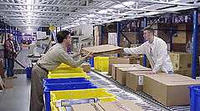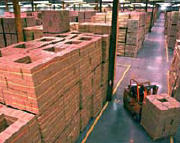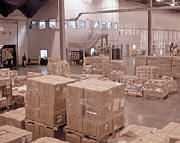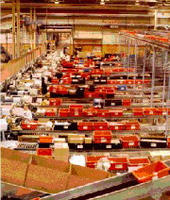Oct. 14, 2002 – In Part 4 of our Special Report Low-Cost RFID: The Way Forward, we described the importance of having a vision for what your company will look like when it is gathering data on everything it makes, moves or sells using RFID. We also talked about the importance of a step-by-step approach. In this section, we’ll look at the use of RFID in warehouses and distribution centers, which will likely be where many implementations start. And we’ll show you how you can move from automating some simple data collection tasks to totally transforming your supply chain.
Members of the Auto-ID Center who are participating in the field test and running their own pilots say that they will start deploying RFID in warehouses and distribution centers by simply using RFID tags instead of bar codes. Initially, they will likely track just what’s coming into and leaving the warehouse with RFID and use bar codes to identify the goods within the warehouse. The benefit: a reduction in the amount of time it takes to match actual goods received or shipped to what the paperwork said should be shipped or received. This is a very basic first step, but the savings involved are significant enough to encourage companies to begin adopting RFID technology.
Labor costs account for 50 to 80 percent of the overall cost of running a distribution center, according to IBM Business Services. Twenty to 30 percent of labor is typically devoted to receiving. If pallets are delivered to the DC with RFID tags, the amount of time it takes to compare the items delivered to the expected delivery can be cut by 60 to 90 percent. (Obviously, much more time is spent confirming goods on a mixed pallet, so it depends on the type of warehouse or DC.)
Installing portal readers is not hard, but it still requires sound engineering. During the first phase of the Auto-ID Center’s field test, portal readers were placed at the exit doors of manufacturing facilities, and at the receiving dock at a Sam’s Club in Tulsa, Oklahoma. Off-the-shelf tags and readers were used to track pallets of All Liquid Detergent, Gillette Mach3 razors and Bounty paper towels as they moved from manufacturing to the retail store. The Intermec tags were read just 78 percent of the time. (The system was designed to make sure that one of two tags on the pallet was read.)
The field test used wooden pallets with two tags in diagonally opposing corners to improve the odds of identifying the pallet. The system was not set up to achieve a 100 percent read rate. It was designed to pick up only one of the two tags on the pallets. So even though the tags were read only 78 percent, 96 percent of all pallets were properly identified. Still, that’s not good enough to justify huge investments in an RFID system. Some of the problems were attributable to human error. Pallets went out doors without readers. Goods were put on pallets without tags. Once, the system was accidentally unplugged. One reader failed, and one antenna was damaged.
The field test used only portal readers, and some sponsors concluded that portal readers alone won’t guarantee a high enough read rate in a DC or warehouse. One solution is to put a reusable, active (battery-powered) tag on the pallet. The tag broadcasts a signal, which is easier to pick up as a forklift moves through a portal than the signal from a passive tag. The ID on the pallet tag is associated in a database with all the goods on the pallet. Such a system can achieve a 100 percent read rate. Then companies can move on to the next level – tracking goods throughout the warehouse or DC.
Someday, every rack and shelf in every warehouse might have an inexpensive reader providing real-time data about what’s on the shelf. But no company today can afford to implement such a system. But it is still possible to use RFID to track where every item is at any given time. The key is to install readers on forklifts and tags on the racks and shelves to identify the location.
One advantage of putting antennas on forklift is it puts the antenna closer to the tag. And since the goods are in the field of the reader for a much longer time than when they move through a portal, read rates improve dramatically. When the forklift picks up a pallet, the tag is read, identifying the goods. As it places the pallet on the shelf or rack, the reader passes close to a tag identifying the location. Warehouse management software will match the pallet to the location.
It’s sound simple, but it’s not quite that simple. International Paper has worked with vendors to develop a forklift reader, but it is likely that one reader won’t fit all forklifts. RFID reader makers point out that it is important to make sure the reader doesn’t interfere with the operation of the forklift. Companies also have to comply with occupational safety rules. And perhaps most important, the system has to be set up so that the reader picks up on the tag on the rack where the pallet is being dropped. With the longer-range UHF tags typically used in warehouses, it is conceivable that the reader will pick up tags from nearby racks. Good engineering and smart system design can overcome the problem. Vendors are also likely to develop products tailored to the needs of warehouses if there is a market for forklift readers.
Noah Dixon, product manager for visibility and warehouse functions at RedPrairie (formerly McHugh Software), estimates that replacing the need to scan bar codes by hand would reduce the amount of time a worker spent moving a pallet by 10 to 20 seconds. That would boost throughput and cut labor costs. The savings? Dixon estimates that a typical medium-size pallet/case warehouse that handles 50 containers a day would save about $125,000 to $150,000 by using RFID tags to track pallets, instead of bar codes. These are hard savings directly attributable to process improvements and reduced labor costs.
Dixon says the savings could be even greater if companies reduce the manpower spent on cycle counts (period physical inventory counts, often done so companies can close their books). In theory, if every pallet coming into the DC is tagged and every pallet leaving is tagged, companies should know exactly what’s in the DC or warehouse at any moment in time. During the Auto-ID Center’s field test, Procter & Gamble found that RFID tracking reduced the time needed to do cycle counts and improved accuracy from 96 percent to 99 percent.
Dixon’s estimate doesn’t include other potential hard savings from RFID tracking, such as a reduction in the amount of time it takes to find items, fewer incorrect deliveries and charge-backs, and reduced losses from spoiled produce. Nor does it include soft savings, such as the potential savings from reducing repetitive stress injuries.
As significant as these benefits may be, they are minor when compared to the benefits companies can get if they can simultaneously reduce inventories while increasing sales by having product on the shelves when customers want it. And that’s where the distribution center becomes critical.
As we pointed out in Part 2: Prospects for Adoption, the return on investment for tracking cases is so compelling that companies will quickly move from tracking pallets to tracking pallets and cases. For retailers, tracking cases can significantly reduce out of stocks, which helps provide a significant return on investment.
At a retail distribution center, pallets from manufacturers are broken down and then reassembled into pallets of mixed products to be sent to individual stores. Today, mixed pallets have the wrong items or the wrong quantity roughly 30 percent of the time, according to some studies. In order to compensate for these errors, retailers order extra inventory and build extra time into the system. By installing readers in the case picking area of the DC, accuracy can be improved to near 100 percent. That reduces out of stocks while also eliminating the need to have extra inventory on hand in case the wrong goods were shipped.
The benefits of tracking cases for manufacturers aren’t as dramatic because it doesn’t directly lead to lower inventory and fewer out of stocks. But it can still result in significant savings. Many large consumer products goods manufacturers try to verify that shipments from DCs are 100 percent accurate. This involves having people check and recheck goods on a mixed pallet. According to IBM Business Services, RFID can reduce labor costs for verification by better than 90 percent, while improving order accuracy. This also reduces the cost of dealing with claims by retailers who say they didn’t get the goods they paid for.
Case and order picking is extremely labor-intensive for both manufacturers and retailers. IBM Business Services estimates that picking can account for as much as half of all labor in a distribution center. By eliminating the need to put bar code labels on cases and scan them and then associate them with the right pallet, an RFID system can reduce the amount of labor involved by 36 percent. Since accuracy also improves, suppliers can cut costs while improving service to their retailers.
Installing such a system doesn’t have to be a major undertaking. Stationary readers can be set up in the case pick area of the distribution center. How and where depends on the setup of the area, the type of product and the nature of the environment. A lot of metal shelving or other RF systems in the area might mean that you have to position readers close to the pallets. Employees need to have some way to ensure that each tag is read as it is put on the pallet. For its field test, the Auto-ID Center installed computer monitors that displayed information from readers, so staff could see when a tag isn’t read.
SAP set up a system for a retail customer in less than two months. Bob Betts, SAP’s senior VP for global supply chain, says such systems can pay for themselves in 30 to 60 days. That’s because the hardware requirements are not extreme. If a company already has a wireless local area network (LAN) installed in the distribution center, it only has to buy the readers and tags. It may also need to upgrade a server to handle the extra data coming from the readers, and it will need to tweak its warehouse management software to take data from RFID tags instead of bar codes. These changes are not difficult, and the benefits can be huge.
IBM Business Services produced a white paper for the Auto-ID Center that spells out the benefits of implementing RFID in the distribution center for a retailer and a manufacturer. The “typical” retailer handles 80 million cases at five distribution centers with a total of 100 dock doors. The manufacturer handles 40 million cases at 10 DCs with 50 dock doors.
The consulting firm estimates that it would cost $800,000 to outfit each manufacturing DC and $1.3 million for each retail DC. The total cost would be $4.3 million for the manufacturer and $4.9 million for the retailer. That includes infrastructure and integration costs, though early adopters are likely to pay more than those who wait until vendors develop off-the-shelf products.
IBM Business Services estimates that the retailer would save $3.8 million a year by tracking pallets. The manufacturer would save $2.7 million. When they move to tracking cases, the manufacturer saves $20.1 million per year and the retailer $33.5 million. The savings come mainly from reducing labor costs and a reduction in claims. IBM also says the retailer would gain $34.4 million from increased sales resulting form having fewer out of stocks. The manufacturer would capture $19 million in lost sales.
This kind of ROI sounds almost too good to be true. Maybe it is, but if companies were to do even half as well as IBM’s theoretical retailer and manufacturer, the ROI would still make it worth deploying an RFID system. Which is why Wal-Mart and P&G are testing RFID’s ability to cut costs across the supply chain and why Unilever is working with RedPrairie to develop a warehouse management software platform that can take advantage of data from RFID tags.
Tagging cases is not, however, the be-all and end-all of the transformation of the distribution center. To realize the full potential of an open RFID system, companies need to transform distribution centers from transshipment points and staging areas into nerve centers that optimize the flow of goods.
One key will be cranking up the pace of deliveries. Retailers have been moving towards smaller and more frequent shipments. RFID will take that to a whole new level. Manufacturers may also be willing to increase the frequency and decrease the size of shipments if they are convinced that the reduction in out of stocks pays for the added cost of additional trips to the retail store or DC. (Research suggests it will, but manufacturers are skeptical.)
Another key is the ability to respond rapidly to the near-real-time information coming from retail stores. That means creating a bottom up management and IT approach. Here’s what we mean. Let’s say a product promotion creates greater than expected demand. Today, most top-down IT systems replan everything across the network of manufacturing facilities and DCs for that item. (Many companies simply hold extra inventory just in case they failed to predict demand accurately, which is worse.) That’s just not going to cut it when you have real-time data that shows a truck is late, a forklift just backed into a pallet, a big order was canceled because of a flood and so on and so on.
In the future, the near-real-time data coming from stores will be transmitted immediately to software agents in the DC, which will compare consumption against the plan and predict an out of stock condition. It will then send a message up to the higher level system and to agents running in the nearest DCs notifying them of the potential shortage and asking for assistance in replenishing. The other systems will send back their ability to provide product for a certain cost and at a certain time. The agent in the original DC will look at a cost-time matrix and choose the delivery that meets the time requirement at the lowest cost. All this will be done within seconds.
The technology to do this exists today. But few companies are even close to being ready to take advantage of it. We expect that it will likely be several years before the RFID systems are in place to provide the data, and business processes and IT systems are set up to respond to the data. Many companies may never cross the chasm, simply because they can’t make the cultural shift needed to become a real-time organization. Those that do make the leap will achieve unprecedented supply chain efficiencies.





